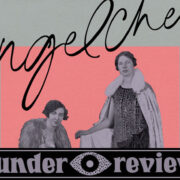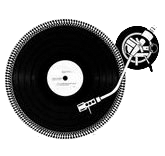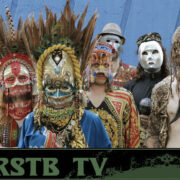Design Inspiration: Chris Reeder 

There have been plenty of touchstone labels around here, but I’d wager to say that Rocket Recordings is up there in the top ten that get referenced on the site. Their take on psych and metal is always interesting and always quality, but aside from just digging up some of the best band, the label also embraces a spotless design aesthetic that I’ve always been attracted to. This comes largely in part from label heads Chris Reeder and John O’Carroll, who both contribute sleeves to their stable of releases. Design in psych and metal can either be transcendent (see Design Inspiration: Arik Roper) or drag the releases into parody. Reeder and O’Carroll fall squarely in the former camp, elevating their releases to art pieces visually as well as aurally.
Reeder and O’Carroll both agreed to contribute picks to Design Inspiration, but I’ll focus first on Chris Reeder. His sleeves have a clean design that’s crisp and classic at the same time, rendering them iconic each time. If you’re familiar with the output of Goat, GNOD, Lay Llamlas, Pigs x 7 and Hey Colossus, then you’ll have an idea of what I’m talking about. Chris dives into five of his all time favorites, but leaves the caveat: “It is really hard to pick only 5 sleeves as so many have meant so much over the years, but on the day I wrote this piece these are the 5 that I wanted to talk about.”

Iron Maiden – Iron Maiden (EMI/Harvest, 1980)
Once my first musical obsession Adam and Ants had stopped making good records I was left in the wilderness of what music to like as nothing really excited me. That was until my closest friend at the time came back from a trip to Germany where he was visiting family. While there his older cousins played him all their heavy metal albums and he was hooked. So, on his return I went around his place and he told me about these new discoveries and played me two albums he had since bought, a Meatloaf record which I didn’t really care for and the brand-new album called Powerslave by a band called Iron Maiden. I remember listening and was blown away, and I knew I had now found the music I was looking for. I was so interested in the sleeve too, it was on a textured paper and was bright and inviting, though it has a sinister edge to it that intrigued me.
Then a few weeks later when visiting my grandparents in Merthyr Tydfil I made my regular trip to the local Woolworths to look through the records and there sat an Iron Maiden album. But this looked so different to Powerslave, this looked dark, dirty, punk so I pulled out my pocket money and bought it straight away. Rushed it back to my grandparents’ place, took the very dusty Perry Como record that had been sat on the deck of their cabinet record player for years and put on the Iron Maiden’s first album, much to my Grandparents’ and Mum’s horror. I stared at the cover for ages and ages, dissecting every detail. I loved that the undead character was a punk – something I identified with. I loved the repetitive symmetry between the street lights, the moon and Eddie’s eyes. I loved the live photo on the back, I wanted to be there! I just became obsessed with the sleeve.
That then made me want to collect all their albums as much for the sleeves as the music. And that led me to become a ‘Maiden and heavy metal fan which a couple of short years later led me to Metallica’s Ride the Lightning and that opened the doors wide open to the world of Thrash! But I think the Derek Riggs Iron Maiden sleeves were an integral part to play in my obsession with music and album art, particularly the concept of consistency. Each sleeve told a story and I still love the 70s/80s Heavy Metal album art today, from the professionally created to the downright basic and undesigned tape scene artwork.

Mudhoney – SuperFuzz Big Muff (Sub Pop, 1988)
I think it was Public Enemy that first turned my head away from only listening to metal. That then led to the wonderful world of ‘crossover’ metal :). About this time, I had just also befriended a guy from my school called John O’Carroll (who I run Rocket Recordings with) in 3rd year art and we chatted about music. He loved Hip-Hop and Electro due to having access to his older brothers record collection. So, he told me about all the great Hip-Hop, I told him about all the great metal and we also met in the middle and explored the world of ‘Crossover’- so bands like Faith No More, Urban Dance Squad, Red Hot Chili Peppers, Jane’s Addiction etc. Then I saw a piece in Kerrang! with a headline saying something along the lines of ‘The New Crossover’ and it featured three bands, Soundgarden, Tad and Mudhoney.
So of course, I was intrigued and popped on the bus into Bristol and went to Replay Records and there was a Mudhoney album. But this sleeve was different, it was black and white, it was very handmade, it felt dirty, it felt alive, it felt raucous – there were guitars, hair and beads in your face, this was no 80s metal sleeve! I was intrigued by this a lot. I remember getting it home and chucking it on and hearing FUZZ properly for the first time. That cover completely described the sound that greeted me inside. They went so well together and that was it – again, I was hooked. The energy and rawness of the sleeve was so the polar opposite to the fantasy, full colour world of metal and it really excited me so I had to delve deeper into this world. Regrettably I then sold a lot of my metal records to help finance this new world of discovery, so I traded my metal/thrash albums for records by Butthole Surfers, Stooges, Loop, Dinosaur Jr, Bad Brains, Minutemen, Rapeman, etc., etc.

Hawkwind – In Search of Space (United Artists, 1971)
Barney Bubbles has to be one of the greatest sleeve designers ever, right? I, like most designers, am a massive fan of his work, the sleeves he did for Glastonbury Faire, The Damned, Red Dirt, Ian Dury, Nick Lowe, Inner City Unit, etc. are all amazing. But it is the design he did for Hawkwind that he is obviously most famous for and rightly so. His sleeves for Hawkwind were, and still are like no other. But for me it was In Search of Space that first really caught my attention and the one I still think is his ultimate masterpiece. And it is not just the amazingly designed, eye popping fold out sleeve, the ‘log book’ that you are greeted with inside is the perfect visual guide to the music, you can’t help but flick through it whenever you put the record on. It is the perfect imagery to a perfect album! I went to a Bubbles exhibition in London and was blown away by his attention to detail and enthusiasm with the concepts and background work he did for all his art – a true visionary.

Boredoms – Rebore Vols 1-3 (WEA Japan/AKA Records, 2000-2001)
There was this record shop in Japan that specialised in music and labels from Bristol… yes, you did read that right! Anyway, Rocket’s mentor, the legend that is Fat Paul, told them about Rocket and the couple who ran Grass Roots contacted me and said they would love to meet up on their next yearly pilgrimage to the UK and buy some Rocket 7″s off of me. This was still in the early days of Rocket, before we fully embarked on releasing albums and our early 7″s didn’t really sell loads at the start so we each (John O’Carroll, Simon Healey and me who ran the label) had several spare personal copies of our catalogue.
Also, around this time, I was a HUGE fan of the Boredoms. I saw them when they first came over to the UK, when the Planet Records guys put them on at the Fleece and Firkin, still when they played with toy instruments, etc. I was quite obsessed with this band and collected whatever albums/singles by them I could find, which wasn’t much tbh! So, I asked if the lovely folks at Grass Roots would be up doing a ‘trade’ and get me what Boredoms vinyl they could find and they said, “yes, that would be a great trade”! So, we met up, I gave them a small bag of Rocket 7″s and they gave me a weighty bag of 12” vinyl. I opened it up and my jaw dropped, Three Rebore LPs (that I didn’t know existed), Super Roots 7 and Super Go.
I put them back in the bag and hid them under my chair, thinking they would realise what crazy trade they had made and would want them back. But no, they were very happy indeed with their trade so both parties left happy! Anyway, after our meeting I couldn’t wait to get home and play these new acquisitions and study their sleeves. And wow! How blown away was I when I opened up the gatefold sleeves of the three Rebore albums? Amazing brightly coloured, airbrushed, psychedelic patterns greeted me and I was so taken aback! TBH, the front sleeves are ok, but the real gold is the art on the inside of the gatefold. Ok, psyched out sleeves are ten a penny these days, but back then in 2000, no one was really doing anything like this, so seeing this great art on the sleeves from one of my favourite bands was very rewarding and influential indeed.

Mats Gustafsson – Original Silence: The First Original Silence (Smalltown Superjazzz, 2007)
I completely fell in love with this record’s cover art as soon as I saw it, and It has been a big influence on my own sleeves design ever since. The designer Kim Hiorthöy is one of my favourite artists working today, he is such a talent! Plus, I have always been a fan of the art of collage, another great collage designer I admire is Julian House, especially his creations for Broadcast, MOJO comps, Berberian Sound Studio etc. But this Mats Gustafsson sleeve has a certain lofi’ness to it that really struck a chord with me. The images, their placement, the typography, the paper stock, its general simplicity… all of it I absolutely love, to me it is perfection. I do get a real satisfaction when creating sleeve art in this area, those endorphins really kick in big time while creating simplistic collages and using ‘undesigned’ mono spaced typography. You can see this style directly on several Rocket sleeves that I have created over the years. Recently I designed a sleeve for a release due next year that had this as an influence – unfortunately that design direction wasn’t chosen by the band but I may have to use the art for another ‘suitable’ release in the future! 🙂












